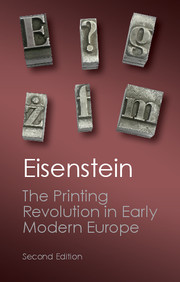Book contents
- Frontmatter
- Contents
- List of Illustrations and Maps
- Preface to the Second Edition
- Introduction
- THE PRINTING REVOLUTION IN EARLY MODERN EUROPE
- PART I THE EMERGENCE OF PRINT CULTURE IN THE WEST
- PART II INTERACTION WITH OTHER DEVELOPMENTS
- Afterword: Revisiting the Printing Revolution
- Selected Reading
- Index
Afterword: Revisiting the Printing Revolution
Published online by Cambridge University Press: 05 October 2013
- Frontmatter
- Contents
- List of Illustrations and Maps
- Preface to the Second Edition
- Introduction
- THE PRINTING REVOLUTION IN EARLY MODERN EUROPE
- PART I THE EMERGENCE OF PRINT CULTURE IN THE WEST
- PART II INTERACTION WITH OTHER DEVELOPMENTS
- Afterword: Revisiting the Printing Revolution
- Selected Reading
- Index
Summary
The writing of history, it is said, entails a dialogue between past and present. Such a dialogue helps to account for the prolonged interest in the topic of this book. The introduction of new communications technologies in recent years has stimulated curiosity about possible historical precedents and has given The Printing Revolution an unexpectedly long lease on life.
But the coming of a new “information age” was still in the future during the decade (the mid-1960s to 70s) that saw publication of my preliminary articles. When I added “some final remarks” to my book, the chief innovation I had in mind was the photocopier. My final version was duplicated not as “hard” copy but on carbon paper. It reflected years of study under the guidance of historians who were influenced by a different set of “present-day” concerns.
Although elementary school teachers had pointed to the introduction of printing as a significant event, the history courses I attended during my years of college and graduate study left the topic out. Advanced courses in medieval and early modern French history provided large bibliographies on a variety of subjects; few of the works on the long lists even mentioned the advent of printing. We were assigned several volumes of a multivolume, collaborative, French series devoted to the “evolution of humanity.” Henri Berr, its original editor, had planned separate books on the development of language, the invention of printing, and the advent of the newspaper.
- Type
- Chapter
- Information
- The Printing Revolution in Early Modern Europe , pp. 313 - 358Publisher: Cambridge University PressPrint publication year: 2012

